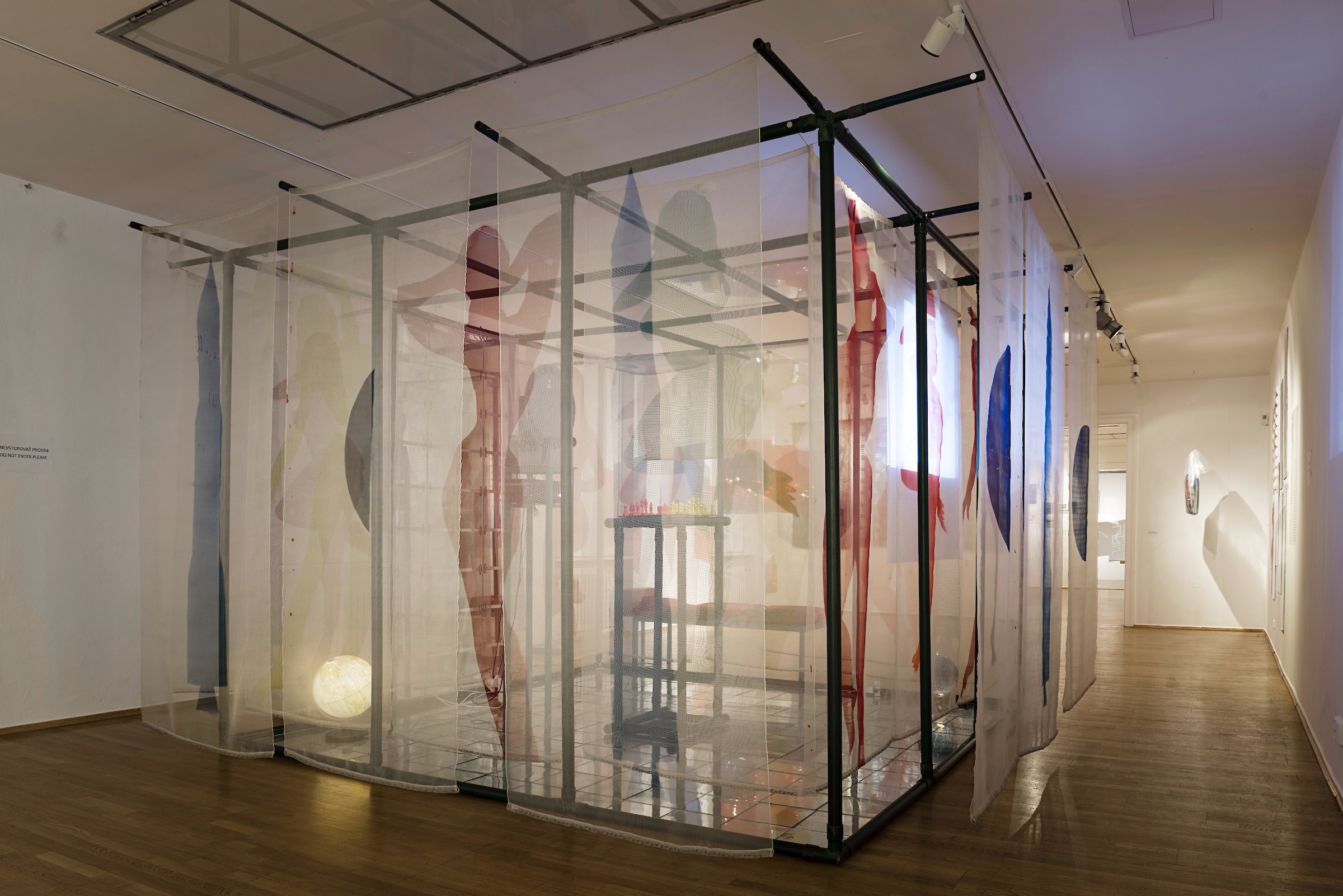The Universal Environment
Side Gallery 2

The Universal Environment / Univerzálne prostredie, 1966 – 67
Environment, various materials
300 × 400 × 400cm
Courtesy The Slovak National Gallery, Bratislava
Filko’s first attempts to open art up to its viewers are already in evidence in the early series The Altar of Contemporaneity (1964−65). In his first large installation, The Universal Environment (1966−67), he then took a next big step toward a concept of the open work of art.
Filko first planned this environment as a walk-in installation. With its scaffold-like see-through cubist structure this installation recalls the formal idioms of modernist architecture. The frame divides the interior space into two vertical fields each accessible by walking through transparent banners, and each with mirrors on the floors. There are various objects with symbolic connotations placed in the interior of the environments. A globe represents the world and another the universe, a chess set stands for strategy and conflict.
In The Universal Environment a slide projector presents different images, including expensive cars and women in pin-up poses — here Filko shows a world based on consumerism and chauvinism. In this installation, the beholder is offered a space of enticing and promising symbols in a theatrical presentation of the alternative values and ideas of Western capitalism and Soviet communism. Filko asks questions as to the temptations and promises behind these political systems and seems in this way to be contrasting the two different ideologies while at the same time showing them from one universal standpoint. The mirrors integrate the beholders into the work and make them also part of a global and inexorable economy of desire.
Monochrome emblematic images are placed both on the semi-transparent curtains and on the works from the two series Map of the World (Rockets) (1967) and Map of the World (Woman) (1966−67) that are attached to the installation. These show rockets and female figures, but highly stylized so as to make them universal signs that inscribe themselves into the order of the world.
These conflicts of power, economics, and sexuality are also evident in the series Reality I.-III. (1966), with its reworked maps of the former Czechoslovakia. In this context Filko talked of the viewers as living sculptures, referring to aspects of an action art that aims to undermine physical or intellectual interpretations in the interaction between the beholders and the installation.
To preserve the artwork the installation cannot be entered or walked on.
The Universal Environment / Univerzálne prostredie, 1966 – 67
Environment, plastic structure, plastic mesh screens with airbrush stencils, acetone paints, terrestrial and celestial globes, mirrors, projector, projection of slides on a screen, chess table, board and pawns
300 x 400 x 400 cm
Courtesy The Slovak National Gallery, Bratislava
From the series Map of the World (Rockets) / Zo série Mapa sveta (Rakety), 1967
Print from a lino stamper, pen, found cartographic print, paper
95 x 39,5 cm
From the series Map of the World (Rockets) / Zo série Mapa sveta (Rakety), 1967
Print from a lino stamper, pen, found cartographic print, paper
95 x 39,2 cm
From the series Map of the World (Woman) / Zo série Mapa sveta (Ženy), 1967
Print from a lino stamper, pen, found cartographic print, paper
95 x 42 cm
From the series Map of the World (Woman) / Zo série Mapa sveta (Ženy), 1967
Print from a lino stamper, pen, found cartographic print, paper
95 x 39,3 cm
From the series Map of the World (Woman) / Zo série Mapa sveta (Ženy), 1966 – 67
Printing ink pressure sprayed through a stencil, found cartographic printing, paper
120,5 x 79 cm
From the series Hemispheres of Earth / Zo série Zemské pologule, 1967
Monotype
87 x 56 cm
Courtesy The Slovak National Gallery, Bratislava
From the series Map of the World (Rockets) / Zo série Mapa Sveta (Rakety), 1967
Monotype
121,4 x 39,1 cm
Courtesy The Slovak National Gallery, Bratislava
Reality I. / Realita I., 1966
Serigraph, etching
33,6 x 49,2 cm
Courtesy The Slovak National Gallery, Bratislava
Reality II. / Realita II., 1966
Serigraph, etching
32,5 x 49 cm
Courtesy The Slovak National Gallery, Bratislava
Reality III. / Realita III., 1966
Serigraph, etching
52,3 x 33 cm
Courtesy The Slovak National Gallery, Bratislava
All works if not otherwise stated Courtesy Linea Collection, Bratislava; Layr, Vienna